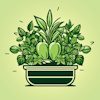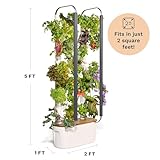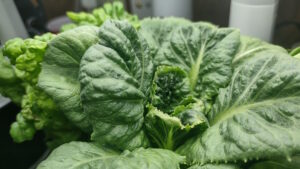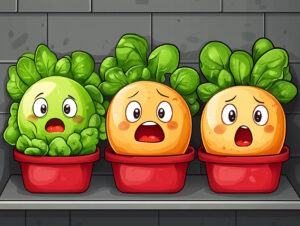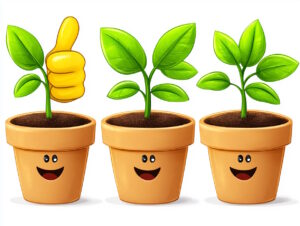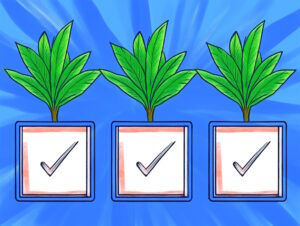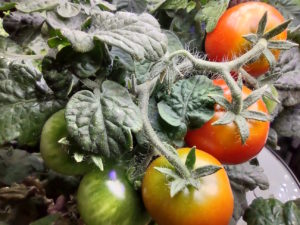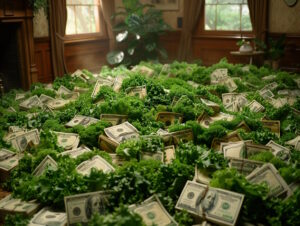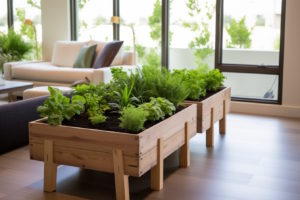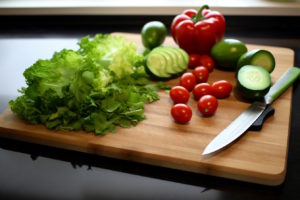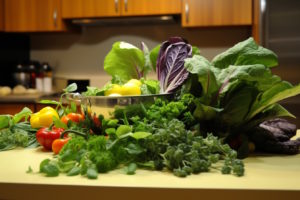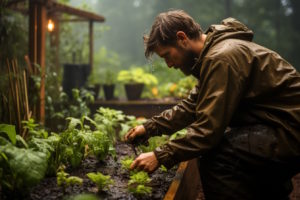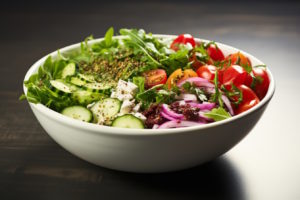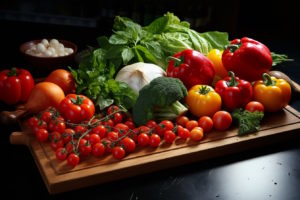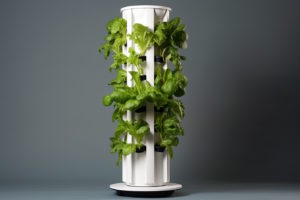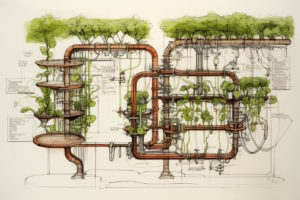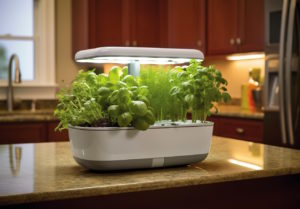How to Plan Your Indoor Garden
You’d like to grow your own food, but you don’t have the time or yard for growing food outdoors. Or, a bad back and aching knees prevent you from the even thinking about it. Maybe you just don’t like being outside. Well, you’re in luck. You can grow an indoor garden that can rival a garden grown outdoors.
It takes planning, time, space, and recognition of the difference between growing indoors and outdoors. It can be work sometimes, but it’s indoors, it’s climate controlled, and—if you want—on a countertop.
Your indoor garden can be small, just a few herbs. Or your indoor garden can replace an outdoor garden. How would you do that, though?
Here are some suggestions and questions for you to consider to help you get started on an indoor garden quickly and for the least cost. Hopefully, answering these questions gets you a jump start on the wonderfully satisfying pursuit of a bountiful indoor garden.
Start A Journal
Ugh. Please, not another reason for a journal! Yes, you should have a journal for tracking your actions and their effects on your garden. There are simply too many variables for you to remember.
Your journal enables you to compare your current crop to past crops. How else will you know whether that seed should have germinated by now, or how many tomatoes you should expect to harvest?
Your journal can be a simple binder of lined paper or a software application. I love Microsoft OneNote for tracking my scattered random thoughts. It runs on just about any major platform. Experiment until you find something that works for you.
To get the most value, you need to have your journal handy when you are tending your indoor garden. If you have to walk across the room to record each of your actions, you’ll tire of the effort and give up on the journal.
Information you’ll log in your journal include the items listed below.
- What you planted and when
- Where you planted (which pod or container)
- When you fed and watered
- When you saw the first evidence of growth
- When the harvesting began
- How much you harvested overall
- When the productive life of the plant ended
It’s optional
Keeping a notebook is optional, of course. It’s your garden, after all. If your interest in a garden ends with a hydroponic growing system and six herbs, you don’t need a journal. Just replace each pod as plants die off.
However, a garden with a purpose requires intent. Keeping a journal proves intent.
- NEXT-LEVEL GROW SYSTEM: Using Aerospring’s patented aeroponic technology, this all-in-one grow system doesn’t require any additional components to grow like a pro. The root zone is contained in the modular vertical pole, and allows the plant’s roots to grow to their greatest potential. In addition to the Aerospring aeroponic system, the grow kit comes with everything you would expect including: 180W grow light, quiet exhaust fan, carbon-filter, metal frame, D600 grow tent.
- HIGH QUALITY 180W LED GROW LIGHT: The all new, Aerospring Hexglow custom 180W custom LED light panel, full-spectrum, professional grow lights, highly efficient at 2.7 (umol/J), light intensity at 1272 PPFD (μmol/s) at 15in, CRI >90, CCT = 4000k, estimated lifespan 50,000 hours. Suitable spectrum for all stages of plant growth. 0-100% light dimmer included. Adjustable light height can be raised as the plant canopy grows.
- DESIGNED BY GARDENERS, FOR GARDENERS: We designed the Aerospring system to be the most usable hydroponic system. Easy access to the water reservoir for water management. The 20 gallon reservoir requires less frequent refilling. Easily detachable internal hose for draining/changing water. The vertical pole is easy to disassemble for cleaning and reassembly, and dishwasher safe. The wheelbase allows for easy movement and rotation for trimming leaves.
- TEMPERATURE CONTROLLED: 4" carbon air filter with Australia virgin charcoal, changeable pre-filter. Quiet 4" inline duct fan with 0-100% variable speed controller, cutting edge brushless EC Motor and dual jet type blades, delivers 160 CFM airflow rate using just 18 watts at maximum speed for discreet and high performance growing.
- GROW TENT FOR DISCREET GROWING: The fully sealable grow tent made with Oxford D600 tent material, with highly reflective white interior panels, increases plant growth while eliminating 100% of light seepage. Two colors available, gray and black, to fit with any interior.
- IN THE BOX: The Aerospring Grower’s Edition Indoor Hydroponic System includes the Aerospring patented vertical pole with 9 plant capacity, 20gal bucket & lid, Aerospring Hexglow custom 180W LED light panel and driver, Quiet 4" inline duct fan, 4" carbon air filter, Powder-coated metal hexagonal frame with wheelbase, Oxford D600 tent, Sicce Syncra Silent 1.5, Smart WiFi Power Strip, SCROG Net, 1L Aerospring Hexgrow (A&B) nutrients, LCD Hygrometer, 9 Grodan Rockwool cubes, 9 Grow cups. Warranty: 12 month manufacturer's warranty on all parts; 24 months manufacturer’s warranty on Hexglow LED light panel; 3+2 year manufacturer’s warranty on Sicce Syncra Silent 1.5 pump. Seedlings not included.
Set Your Budget
A budget is just a plan for how you’ll spend a resource. For planning your garden, you’ll set up a budget for your money and your time.
Your budget helps you prioritize where you spend your gardening money and time. Your money and time are finite; they’re limited resources. Make every purchase count and maximize the results of your invested time.
With each plant or component you plan to add to your indoor garden, ask yourself these budgeting questions.
- Is the money I spend on this item furthering the purpose of my garden?
- What is the initial cost in dollars?
- What are the recurring financial costs?
- Is the time I'll invest in this furthering the purpose of my garden?
- What is the initial cost in time?
- What are the recurring costs in time?
Your initial financial cost might be the purchase price of a hydroponic growing system. The recurring financial costs include the electricity, pod kits, and seeds.
Your initial cost in time would be arranging space for the new component to your indoor garden and set-up time. Ongoing time commitments include cleaning, pruning, and harvesting plants, but also cleaning and maintaining the equipment between crops.
And anything you buy or do should further the purpose of your garden. If you are scattered in what you buy and do, you’ll have a collection of expensive, random plants.
Convenience versus savings
You can save a lot of time if you spend more money. You can save a lot of money if you spend more time.
Your indoor garden can consist of ten hydroponic growing systems. At the hypothetical price of $90 each, you’ve spent $900 to grow sixty to ninety plants indoors. (That’s 10 planters multiplied by 6 or 9 pods per planter.) This is choosing time convenience over savings. Your ten little indoor gardens do almost all the work for you.
If you wanted to grow the same sixty to ninety plants indoors, but are severely limited in funds, you can build your own hydroponic growing systems. You design the system; buy the pump, plumbing, water reservoir, and lights; and assemble it yourself. You maintain the equipment and check on your plants often. Perhaps you achieve an equivalent indoor garden for $400. You paid for this cost savings with your time.
(Note that compared to the cost of building, filling, and maintaining outdoor raised beds you can only use half the year, neither indoor garden strategy is outrageous.)
The conflict between convenience and savings matters less for small gardens. If you purchase a single hydroponic growing system and stop there, you’ve maximized convenience and savings. To grow six to nine plants in a hydroponic system, you would likely spend more money and time to buy and assemble all the components than you would to just buy the indoor garden kit.
Timing your purchases to stretch your budget
Once you’ve read this entire article, you’ll have built a shopping list and have the ability to estimate the purchase cost of all the materials. Unless you are in a hurry to buy everything to get started immediately (I understand!), you can stretch your budget by catching sales to save money.
Amazon has in the past held a large sale in July and another in October when you can get gardening equipment on sale. Black Friday and Cyber Monday deals still offer opportunities to save money. Spring-time sales at the big box stores include countless discounted gardening tools, and although the focus is mostly on outdoor gardens, you can get some great deals for your indoor garden.
In the example above, the ten hydroponic growing systems cost a total of $900 at regular price. Would your plans for your indoor garden change if you bought those ten units for $50 each on sale? Or if you collected all the do-it-yourself materials for only $300? The cost penalty for the convenience is much lower here.
- Full Spectrum 2020T Grow Lights: This greenhouse kit features four 1.6 foot T5 LED lights. Each 20W grow light provides a full-spectrum (400-780 nm) 3700K warm white light. The dual reflectors focus the light on plants while protecting your eyes. The lights can be linked up to 6 units
- 4-tier Small Greenhouse with Shelves: Each 19-inch-wide plant shelf can accommodate your plant pots with ease. With high-quality metal shelves and heavy-duty bearing nets, it caters to more seed trays and growing lights. Despite its lightweight nature, this greenhouse cabinet indoor ensures long-term use, measuring 26.4"L X 19"W x 61"H
- Greenhouse with Durable PVC Cover: Discover the functionality of our mini indoor greenhouse, ideal for both indoor and outdoor use with its clear PVC cover. These plant shelves provide an ideal growth environment for your plants, protecting them from frost and rain. Featuring a zippered roll-up door, it caters to various weather conditions
- Memory Timer: This small indoor greenhouse with timer offers 4/9/14-hour auto on/off settings. It features a memory function that recalls your last timing mode for quick setup next time. If power is interrupted, the timer will need to be reset once restored
- Tool-free Assembly: Experience the simplicity and convenience of our mini greenhouse. With tool-free assembly, it's easy to set up this portable greenhouse. The roll-up zippered door ensures easy watering and misting. As the seasons change, it folds compactly into a storage bag, embodying the essence of greenhouses. An included instruction sheet makes assembly effortless
List What You Intend To Grow
Make a list of all the plants you think you’d like to plant, even if it’s a ways in the future. Leave room beside each plant to add more information. A spreadsheet might be a convenient tool for this exercise.
What you want to grow affects your decision on what materials you’ll need to grow it.
Why did you list those plants?
Why do you want to grow the plants on your list? You probably aren’t growing lettuce to grab a couple leaves to snack on during the commute to work. That lettuce is part of a greater plan. What is that plan?
Next to each plant on your list, write your reasons for wanting to grow it. You might want to use a plant for salads, a salsa recipe, general seasoning, a snack right off the vine, and so on. Your plants might have more than one reason. And if you’re growing that plant just to see if you can do it, that’s fine. Write that reason with the rest of them.
You defined the purpose of your garden by listing why you want to grow each plant. Growing random herbs and veggies can be fun, but you risk wasting unharvested food if you don’t have a use for it when it ripens.
If you have a salsa recipe that tastes better with fresh ingredients, focus on how to grow cilantro, tomatoes, and peppers. If you are a wonderful (or aspiring) chef who loves customizing your meals, growing a collection of herbs might be your garden’s purpose. For a salad, you should consider a selection of lettuce, kale, tomatoes, carrots, cucumbers, and radishes.
Look at your wish list of plants with the reasons for growing each plant. What stands out as the most appealing purpose for your bountiful indoor garden? Write down, “The purpose of my garden is {insert purpose here}.” Before you start growing any plants, read what you wrote and ask yourself whether that new plant supports the purpose of your indoor garden.
Highlight the rows for the plants that fulfill the purpose of your indoor garden. These are the plants you’ll focus on to the exclusion of all other plants until you have a consistent and continuous harvest of these plants.
Plants | Salad | Snack | Cooking |
|---|---|---|---|
Cherry Tomatoes | Yes | Yes | No |
Bell Peppers | Yes | Yes | Yes |
Cucumbers | Yes | No | No |
Radishes | Yes | No | No |
Carrots | Yes | Yes | Yes |
Strawberries | No | Yes | No |
Cilantro | No | No | Yes |
Lettuce : Black Seeded Simpson | Yes | No | No |
Lettuce : Romaine | Yes | No | No |
Lettuce : Grand Rapids | Yes | No | No |
Lettuce : Salad Bowl | Yes | No | No |
Lettuce : Prizehead | Yes | No | No |
Spinach | Yes | No | No |
Kale | Yes | No | No |
Oregano | No | No | Yes |
The sample table above illustrates my list of plants for growing indoors. I determined the purpose of my garden will be salads and emphasized the names of plants dedicated to salads.
I can eat cherry tomatoes as snacks, according to my table above, but to do so reduces the number of tomatoes I have available for salads.
Alternatively, I can grow cilantro and oregano for recipes, but this takes away capacity I could use to grow more lettuce. It’s a trade-off if I don’t have capacity to do both.
Consider The Characteristics Of Your Plants
You have a list of the plants you’ll need to grow to fulfill the purpose of your garden. Now you’ll define the characteristics of each plant so you can set up your garden appropriately.
You’ll add columns to the list of plants you wish to grow. Here are ideas for the columns and the information you’ll include in each.
- Exclusively Soil: Is the plant root-based, as are carrots and radishes?
- Height: How high can you expect this plant to grow?
- Width: How wide can you expect this plant to grow?
- Depth: How deep (if a root crop) can you expect this plant to grow?
- Volume: How much food do you expect one plant to offer?
- Assistance: What external assistance (trellis, fan, etc.) benefits the plant?
- Growth: How quickly does the plant reach maturity?
The information you’re collecting directly affects how you’ll arrange your indoor garden. You may not be able to answer all these questions until you’ve grown the plants yourself. Part of the joy of gardening is the learning.
The height of the plant may exceed the height of the hydroponic growing system. Only the leaves below the LED grow light get the “sunlight”. This is not a show-stopper, however. I’ve had pepper and tomato plants grow beyond the reach of the grow light and happily continue producing fruit.
Now, if your hydroponic growing system is under your kitchen cabinets and you plant peppers, they’ll likely bump into the bottom of your cabinets unless you grow varieties designed to stop growing at a low height.
Width matters because even a dwarf tomato plant will crowd out all other plants if you are growing your plants in a countertop hydroponic growing system. You have six or nine seats for pods, but a healthy tomato plant can block the light to the other pods.
This brings up an important point about hydroponic growing systems. Just because you can seat six, nine, or twelve pods does not mean you can fit six, nine, or twelve plants under the grow light. One point of this exercise is to determine how far apart you need to space your plants.
Get more specific with the type of plants
You know in general what you want to grow (for example, lettuce). Take a few minutes to name specific types of lettuce you’ll add to your garden.
Iceberg lettuce may be a poor choice for a hydroponics growing system (unless iceberg lettuce really is the purpose of your garden, of course), but Black Seeded Simpson grows well. You want varieties that allow you to clip leaves as you need them rather than waiting for the entire plant to mature to harvest anything.
Buy a variety of lettuce seeds to grow as an experiment, if lettuce is one of your target plants. If you’ve only bought lettuce at the grocery store, you’ve probably only had iceberg, romaine, and one or two other varieties from which to choose. You have many options, now! This applies to tomatoes, peppers, and many other plants.
- Variety Pack: This collection contains 14 heirloom varieties of lettuce. Iceberg, Black Seeded Simpson, Red Romaine, Parris Island COS Romaine, Lollo Rosso, Oakleaf, Buttercrunch, White Boston, Marvel of Four Seasons, Bronze Mignonette and more!
- Growing Ease: Lettuce seeds germinate quickly, typically within 7-10 days, when sown shallowly in fertile, well-drained soil and kept moist, making it an accessible crop for beginner gardeners.
- Climate Preference: Lettuce typically thrives in cooler temperatures, preferring partial shade in warmer regions, and can be harvested early as baby greens or later as mature heads in 45-60 days.
- Flavor and Texture: Offers a spectrum of tastes from mild and buttery (butterheads) to slightly bitter (lollo rosso) and earthy (red romaine), with textures ranging from crunchy (iceberg) to tender (buttercrunch).
- Quality: All Lettuce seeds packaged by Seed Needs are intended for the current and the following growing seasons. All seeds are stored in a temperature controlled facility that is free of significant amounts of moisture.
- Quantity: Seed Needs offers generous quantities. You can share with friends and family, or you can save the extra seeds until the following season, if properly stored.
- Packets: Each seed packet displays an artful illustration of the variety to be grown, as well as detailed seed sowing information on the reverse side. They measure 3.5" wide by 5" tall.
- Promise: Seed Needs will never knowingly supply GMO based seed products. The vast majority of our seeds are open pollinated & heirloom, with the exception of a few hybrids.
- Germination: Seed Needs packets contain some of the freshest seed available. Direct from the growers. If sown correctly, you will begin seeing results in only a matter of days.
- Freshness: All Lettuce seeds are packaged in tear resistant and moisture resistant packaging. This keeps the seeds a whole lot fresher than the competitions selection!
Is Your Home Garden-Ready?
Yes, your home almost assuredly is garden-ready. Few homes won’t accommodate a hydroponic growing system. It just needs a square foot of counter space and an electrical outlet. But beyond that, what are the physical considerations for an in-home garden?
Electrical demands
Electricity is a must for all but the most primitive indoor gardens. Unless you have a room with glass walls and ceiling—effectively an attached greenhouse—you’ll need artificial light. That requires electricity.
You’ll get fruit from self-pollinating plants like tomatoes and crisper lettuce if you have a fan agitating your plants. That, too, requires electricity.
As you add hydroponic growing systems or grow lights or fans as your garden grows, you’ll need to spread out your electrical devices. In your house, multiple devices connect to a single breaker. That breaker cuts the power to those devices if they exceed the capacity of the breaker.
Distribute your devices across multiple breakers if your electrical demands approach the capacity of your breaker.
Pay attention to the power schedule of your devices. Avoid having every device start at the same time. If you have several hydroponic growing systems, that means staggering times the LED lights turn on. Many devices draw more electricity to start than they do to run. If they all turn on at the same time, with their higher start–up draw, they could trip the breaker.
Remember, multiple outlets connect to a single breaker, and your garden devices might not be the only ones pulling electricity from that one breaker.
Space and location demands
Your garden needs space in your home and the location you choose depends on a few factors.
If you are going old-school, you need a south-facing window and a large window sill. You’ll grow your plants in soil in containers. The space is small, because you’re limited by the available natural sunlight. The location is set, again because you’re limited to natural sunlight.
Thanks to modern technology, natural sunlight no longer holds your indoor garden hostage. Lights designed to mimic sunlight allow you to place your garden anywhere in your house.
You can cram a lot of garden in a small space, especially with a hydroponic system. A hydroponic growing system can grow up to a dozen medium-sized plants at once on your kitchen counter or two dozen large plants on the floor in a unit the size of an end-table. A full-scale hydroponic system (not the hydroponic growing system) can grow a hundred heads of lettuce in very limited space.
So, you can place artificial sunlight on a plant anywhere in your house and can cram many plants into a small surface area. Can this get any better? Yes!
You can grow plants in a vertical garden. This is a column rising anywhere from a couple feet to eight feet in the air with plants growing from openings all the way around and all the way up the column. Read more about vertical gardens in this post, Limited Floor Space? Go Vertical With Your Garden!
You can grow more plants in containers of soil by arranging the containers on a rack unit. Mount a rectangular LED grow light on the underside of each shelf. The plants on each shelf (except the top shelf) will get enough light to thrive. Plug the lights into a timer to automate the day/night cycles.
On a five–shelf rack, you get four lit shelves, which is like having three extra gardens versus what you’d have floor space for without the rack. Plus, you get the bonus top shelf where you can store garden equipment.
- NEXT-GENERATION HYDROPONIC SYSTEM: The Gardyn 4.0 is a cutting-edge hydroponics growing system kit designed to grow 30 large indoor plants in just 2 sq. ft. using 95% less water. With redesigned columns for easy cleaning, energy-efficient LED grow lights, sunrise & sunset lighting modes, and real-time water measurement, this smart garden delivers everything you need for a thriving vertical garden at home.
- 30 FREE PLANTS INCLUDED: Each Gardyn hydroponic garden comes with 30 yCubes containing multiple non-GMO seeds in rockwool for optimal germination. Enjoy a curated mix of vegetables, herbs, and leafy greens to kickstart your indoor herb garden kit - no soil, no mess, just effortless harvest-to-table freshness.
- EASY INDOOR GARDENING: Designed for homes, apartments, schools, and kitchens, this hydroponic planter requires only power and Wi-Fi to run, no water line necessary. With its automatic watering and ideal LED lighting, this indoor gardening system makes growing your own produce as easy as having an indoor greenhouse kit.
- SUSTAINABLE & STYLISH DESIGN: Crafted with brushed aluminum, BPA-free recyclable plastics, and a beautifully finished Rubberwood lid, Gardyn’s indoor herb garden blends eco-conscious design with modern elegance. Compostable yCubes, recyclable packaging, and a compact footprint make this herb garden planter indoor kit both sustainable and space-saving.
- SMART GARDEN TECHNOLOGY: Gardyn transforms indoor gardening into a personalized experience with Kelby, your AI plant coach. With a 30-day trial and 10 bonus yCubes included, Kelby monitors your hydroponic system using advanced sensors and provides tailored care tips, making your hydroponic planter a true difference-maker in growing healthy, flavorful food indoors.
How Much Do You Intend To Grow?
You’ve determined the purpose of your garden, be it a salad, herbs for cooking, or ingredients for your salsa recipe. Now, you’ll calculate how much you have to grow to meet your needs.
When planning how much to grow, you’ll find this article helpful: How To Get A Salad Every Day From Your Indoor Garden. Use the recommendations in that article to set up a routine for growing your plants that ensures you always have the food you want.
How many people are you feeding from your indoor garden? Multiply all your calculations by that number.
Essentially, if you want a continuous supply of a particular food, such as tomatoes, you need to plan to overlap your crops in such a way as to always have one crop producing food while one or two other crops are in earlier stages of growth. Starting one crop only after the current crop dies leaves you with no produce until the next crop matures. You’re looking to avoid that gap between crops.
You may also need more than one of certain types of plants per crop. How quickly will you harvest all the leaves on a single spine of romaine lettuce? How many lettuce plants do you need to grow so you always have a reasonable supply to harvest? If you need six mature lettuce plants to produce enough leaves to fill your daily salad bowl, that’s one six-pod hydroponic growing system right there.
The amount of food you want to grow determines your capacity needs. If you decide you want three varieties of lettuce for two salads a day, maybe you need two six-pod hydroponic growing systems. Twelve pods means two sets of three lettuce plants being harvested and two sets growing to replace them. Once you run that schedule for a while, you adapt based upon your findings. Maybe you need even more capacity. Maybe not.
Is This For Fun Or Maximum Yield?
What is your level of dedication to your indoor garden?
Is your indoor garden a leisurely hobby, meant solely to supply a few herbs to the homemade spaghetti sauce on Tuesday nights?
Or is this a serious endeavor to diversify your food sources without the neighbors finding out?
Or perhaps you have seen how expensive fresh food has become and you want to grow a safe alternative.
If this garden is for fun, meaning you’ll be disappointed if a crop fails, but you’ll just clean out the hydroponic growing system and start over, you need do nothing more right now. Although, if there is the possibility you’ll get more serious later, consider keeping that journal.
If this garden is considered a replacement for the grocery store or for survival readiness, you need to treat it with a high level of seriousness. Meticulously track your actions and their effects on your plants. Increase the capacity of your garden as necessary to meet your objectives. Be scientific in your analysis. Experiment with alternative sources of plant nutrients and feeding schedules. Stock up on plant food so you never run low.
If you are maximizing your yield, study up on how to preserve your harvest. How long can you store peppers in the freezer? Can you grow food you can preserve through canning? Nothing says you cannot grow green beans indoors year-round!
Consider why you want an indoor garden now. If this is a serious project, become an expert on growing food in your own home.
How Hands-On Will You Be?
An indoor garden is certainly more convenient than growing outdoors and the ability to grow food year-round is wonderful. But growing your garden indoors is not effortless. How much effort do you want to put in?
Probably the indoor garden requiring the least effort from you would be the hydroponic growing system. It’s about as close to plug ’n’ play as an indoor garden gets. There’s nothing wrong with growing your entire garden this way, so long as you have the room and your house can supply the electricity.
The more hands-on you are, the more formal your planning should be. Growing in soil is certainly more hands-on.
How involved can you get with your indoor garden?
You can build your own hydroponic growing systems. The benefit of doing this is having a large number of plants in a large reservoir or one large plant in a large reservoir. The downside is that this method is utilitarian and less decorative than a store-bought system.
You’ll be more hands-on by purchasing components of your indoor garden individually. For example, you can buy stand-alone LED grow lights for use with container plants or flats of seedlings. You can move a stand-alone LED grow light to a different plant or adjust the angle. Maybe you want more than one supporting a single large plant. You can be flexible if you get your own components.
So, as part of your planning, gauge whether you want to set it and forget it or if you want to manage every nuance of your plants’ growth.
-
 EarthBox 80151 Garden Kit, Organic, Green *$72.06As of: November 13, 2025 12:15 AM
EarthBox 80151 Garden Kit, Organic, Green *$72.06As of: November 13, 2025 12:15 AM -
 EarthBox 81755 Garden Kit, White *$63.62
EarthBox 81755 Garden Kit, White *$63.62 As of: November 12, 2025 9:15 PM
As of: November 12, 2025 9:15 PM -
 Emsco Group City Picker Raised Bed Grow Box – Self Watering and Improved Aeratio... *Not availableAs of: November 12, 2025 8:15 PM
Emsco Group City Picker Raised Bed Grow Box – Self Watering and Improved Aeratio... *Not availableAs of: November 12, 2025 8:15 PM -
 Keter Urban Bloomer 12.7 Gallon Raised Garden Bed and Outdoor Herb Garden Plante... *$73.99
Keter Urban Bloomer 12.7 Gallon Raised Garden Bed and Outdoor Herb Garden Plante... *$73.99 As of: November 13, 2025 12:15 AM
As of: November 13, 2025 12:15 AM
Do You Prefer Soil, Hydroponics, Or A Combination?
You have your list of preferred plants derived from the list of all the plants you wish to grow. One column should be whether the plant can grow in soil, hydroponics, or either. Do you have a preference?
You may prefer growing plants in soil. Perhaps you’ve had an outdoor garden for years and you’re comfortable with soil-based plants. That’s fine. To grow your plants indoors, you’ll need one or more LED grow lights and containers of the proper size. A shelf unit provides you the ability to fit more plants in a small space. You can mount LED grow lights under each shelf to make for excellent growing areas. If you suspend the lights from the shelves with chains, you can adjust the height of the lights above the plants.
Hydroponic growing systems are certainly an easy soil-less solution. Hydroponics are very popular. You can buy a large-scale hydroponics system or build one. Hydroponics can be done well with PVC pipes and a water pump in a reservoir. You connect the PVC pipes, drill holes for the pods, and set up the pump to push water through the pipes at regular intervals.
Most plants will do well in either environment. Surprisingly, you can grow root plants like carrots in a hydroponic system (with good planning). But realistically, carrots and radishes are soil-based plants. If you’re just starting off, maybe your salad (with ingredients from the sample table above) will include store-bought carrots and radishes so you can focus on the plants growing in the hydroponics growing systems.
If you are serious about growing a varied and bountiful indoor garden, then for each plant determine the best grow medium and implement that. Yield to the best environment for the plant instead of going with the environment most convenient for you.
Let your garden be educational as well as fun. If you’ve planted in soil all your life, get an inexpensive hydroponic growing system and experiment with growing your favorite plants. Or, on the flip side, maybe you can get your hands dirty and grow some radishes in soil indoors.
How Experienced A Gardener Are You?
In planning your indoor garden, set reasonable expectations. If you’ve never grown anything before in your life, start small and grow your garden over time. Alternatively, if you are an experienced gardener outdoors, you have some unlearning to do. Indoor gardens are not outdoor gardens indoors.
You have your list of plants associated with the desired purpose of your garden. You know those plants grow in soil or hydroponics. The biggest change is seasons no longer matter.
If you are an inexperienced gardener, consider starting with plants that thrive in a hydroponic growing system. You want to keep that “new project” enthusiasm by getting quick results from your garden. Look at herbs, lettuce, or specialty tomato plants early on. If you want to try your hand growing food in soil, consider beginning with radishes. They grow quickly and take very little space.
As a new gardener, you will benefit greatly from keeping your journal. This is especially true if you grow multiple plants starting off. It’s just too much to remember.
If you’re familiar with growing plants, but new to indoor gardening, expect just a few changes.
Do You Also Garden Outdoors?
If you will be gardening outdoors, too, you’ll find your indoor garden to be a great benefit. Your indoor garden can help you start your outdoor plants much earlier each spring.
Equipment for starting spring seeds early
You may already have a flat for starting seeds indoors. There are three things you’ll find very helpful you may not already have.
First, you can encourage seed growth with a heating pad underneath your flat. The pad gives your seeds a favorable germination temperature.
Second, you can promote healthy seedlings with a grow light. Without enough light, your plants will be weak and spindly. If you are starting your seeds indoors in the spring by setting the pots or tray near a window, you owe it to yourself to investigate LED grow lights. With the dedicated light, your plants should be much stronger when you move them outdoors.
Third, a 24-pod seed-starter tray in an AeroGarden hydroponic growing system gives your seeds a jump start on life. The hydroponic system with the automated watering and bright LED grow light expedites your plants’ growth. Simply move the grow plug from the tray to the soil when the time is right.
Equipment such as these improve your chances of success growing plants outdoors. They can also save you a great deal of money, considering the difference in cost between a packet of seeds and just one seedling bought at a big box store.
Planning to start spring seeds early
Your indoor garden can help you get a huge jump start on planting in the spring with the above suggestions. However, it comes from planning. You need to schedule off time for your indoor garden to free up the AeroGarden, for instance.
Mark the time on the calendar now for when you’ll be starting seeds for an outdoor garden. Set a reminder to not start a garden in your AeroGarden right before that time, if you are using a starter tray.
If you are using trays, set reminders on your calendar now for when to start seeds for each plant.
Count how many plants of each type you want to plant outdoors and make sure you have the capacity to grow that many seeds indoors. Do you have enough flat trays, if that is your preferred technique?
Reserve shelf space on your rack for soil seed starters and a LED light.
Have a plan in case of a very late frost. As the plants outgrow their starter tray, can you move them to larger pots, like a four inch cup? You’ll need more surface space than a flat and at least one more LED light. You’ll also need more soil.
Bringing plants in for winter
You can bring some plants in for the winter. Each plant’s needs are different. However, the time to think of over-wintering plants is during the summertime. You need the soil, the container, a grow light (for some plants), and a favorable place to put them.
Plants don’t always do well being uprooted and moved indoors. If you’ve never done this before, research how. Be sure you have a storage area that remains within the correct temperature range for your plants.
Be practical. Why are you trying to preserve this plant? Can you not just start a new one in the spring? Maybe you can just start a new one from seed and grow it indoors. Could you grow something else over the winter in the space in your home this plant is going to take?
Do You Intend To Reuse Seeds?
If you intend to capture seeds so you don’t need to buy them next season, you’ll want to choose your starter seeds carefully.
When buying seeds, look for these designations.
- Non-GMO
- Heirloom
GMO means the plant is genetically modified, so non-GMO means the plant has not been genetically modified. Heirloom means you can use the seeds to grow the next generation of plants.
Each plant has unique steps you’ll follow to save its seeds. As seeds come late in some plants’ lives, you’ll have to allow your plants to continue growing past the point at which you’ll be harvesting food. Keep this in mind if you’re growing plants to eat. You may need to increase your indoor garden capacity to offset the loss in production from the plants still growing for their seeds.
What Are Your Physical Limitations?
Small hydroponic growing systems are fairly easy to move, even when filled with water. A typical hydroponic growing system holds approximately a gallon of water, which weighs about 8 pounds. Even with plants, a countertop hydroponic growing system probably weighs under 20 pounds. You’ll need to be able to rotate, lift, and move a tub of water.
Height is a consideration as well. Some plants grow taller than the LED light at its highest extension. Will this be a problem? Can you set the hydroponic growing system or container lower?
For You Or A Gift?
The article focused on your interest in starting an indoor garden. However, if you know somebody you believe would enjoy growing their own food indoors, you can apply most of the above questions and suggestions to that person as the recipient of your gift of an indoor garden. Simply answer the questions to the best of your ability from the perspective of the gift recipient. Your efforts will assist you in finding quite the thoughtful gift.
Key Takeaways
The technology and techniques for growing food have advanced greatly in recent years. Your indoor garden can take over growing most plants from your outdoor garden. With hydroponics and vertical gardens and artificial sunlight, you can grow more food in less space indoors. And you can distribute your harvest over the course of the entire year rather than getting it all at once.
You can put as little or as much planning as you want into your garden; it’s your garden. However, you’d sink a lot of time and money into setting up and maintaining an outdoor garden, so applying a percentage of that effort toward the success of an indoor garden is to be expected.
You can set up your entire indoor garden using hydroponic growing systems from a variety of manufacturers and you’ll have the means to grow an impressive garden. All you need is the room to do it. Don’t feel obligated to replicate an outdoor garden indoors. And don’t feel like using hydroponic growing systems is cheating. Growing a bountiful indoor garden with little effort is winning.
You can grow your indoor garden all year long. For this reason, your entire strategy changes. You can stagger your crops so you’ll always have a producing plant. There are no seasons indoors; it’s always growing time.
Preparing an environment and scheduling your crops for your indoor garden increases your return on your investment. Whatever the purpose of your garden, with what you’ve learned here, you should be able to achieve you goals. And have fun doing it.
- Miracle-Gro Seed Starting Potting Mix is specially formulated for fast root development, and is excellent for starting cuttings
- This potting medium is enriched with Miracle-Gro Plant Food
- Excellent for germinating vegetable, flower and herb seeds, and for starting leaf, stem and root cuttings
- To start seeds, fill a container with mix, plant seeds according to packet directions, and water
- Bundle includes three 8 qt. bags of Miracle-Gro Seed Starting Potting Mix
You Have A New Hydroponic Growing System. Now What?
You have a new indoor garden and high hopes. What do you do next?
Keep ReadingSurviving in a Post-AeroGarden World
AeroGarden announced its closing effective the first of January, 2025. Farewell, good friend.
Keep ReadingThe Most Reviewed Indoor Gardening Equipment
You don’t get thousands or tens of thousands of reviews by being a horrible product. What works? Find out here.
Keep Reading32 Factors to Consider When Setting Up Your Indoor Garden
Avoid making simple mistakes when you set up your indoor garden.
Keep ReadingYou Can Grow Tomatoes Indoors
You can grow delicious tomatoes indoors all year long, and it’s actually quite easy. Get started now!
Keep ReadingIs Indoor Gardening Expensive?
Is gardening indoors expensive? Relatively, no.
Keep ReadingA Raised Bed Garden Indoors? Bring It On!
Learn how to grow your food indoors using an indoor garden bed.
Keep ReadingTips For Growing A Bountiful Indoor Garden
Make your life easier and grow more food indoors with these tips, tricks, and suggestions.
Keep ReadingHow to Choose Your Hydroponic Growing System
Ready to buy a hydroponic growing system, but not sure what features matter? Start here!
Keep ReadingHow to Plan Your Indoor Garden
Get more from your indoor garden by gardening with a purpose.
Keep ReadingIndoor Gardens Aren’t Outdoor Gardens Indoors
When you grow your garden indoors, you leave the old traditions and limitations outdoors.
Keep ReadingHow to Get a Salad Every Day from Your Indoor Garden
You can grow an indoor salad all year long. Learn how!
Keep ReadingWhat Can I Grow with My Indoor Garden?
Spoiler alert: Almost anything! This is a LONG list. And it’s really easy.
Keep ReadingLimited Floor Space? Go Vertical With Your Garden!
Learn about vertical indoor gardens and discover your options.
Keep ReadingHow a Self-Watering Hydroponic System Works
Get the best self-watering hydroponic system by learning how they work.
Keep ReadingWhy Your Outdoor Garden Should Be Indoors
Bring your garden indoors for year-round produce without the back-aches.
Keep Reading
